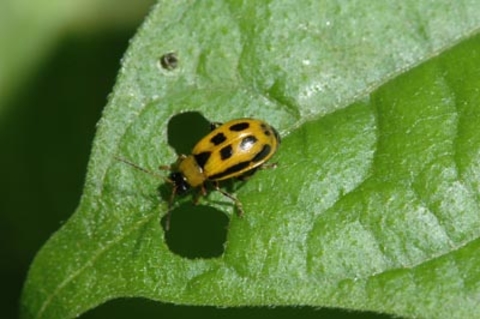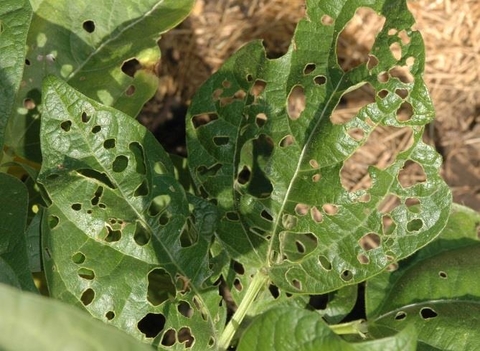Quick facts
- The bean leaf beetle (Cerotoma trifurcata) is a pest of snap beans (also called string beans or green beans).
- Adult beetles feed on the undersides of leaves, creating round, 1/8 inch diameter holes.
- They can also feed directly on the pod.
- Adults are active from mid-May to early June and mid-July through September.
- Bean leaf beetles are generally more common in southern Minnesota than in the northern part of the state.
How to identify bean leaf beetles
- Adults are about 1/4 inch-long, oval-shaped insects, with heads visible from above.
- Most bean leaf beetles in Minnesota are yellowish-green, but may also be red or orange, with four black spots and black markings along the outside margins of the wings.
- Some may lack spots.
- All bean leaf beetles have a black triangle at the top of their wing covers.
Life cycle of bean leaf beetles
- Adult bean leaf beetles spend the winter in the soil under leaves (especially in wooded areas), in clumps of grass or inside dried curled leaves in leaf litter.
- They emerge from mid‑May to early June. They feed, then mate.
- Females lay clusters of about 12 orange eggs in the soil around the base of the beans.
- In addition to snap beans (also called green beans or string beans), they also feed on soybeans, clover, dry edible beans, vetch, alfalfa, and several related weeds
- Eggs hatch into larvae one to three weeks later, depending on temperature.
- White larvae feed on the roots of the bean plant, causing only minor damage to plants.
- Larvae feed for about two to three weeks and then transform into pupae in the soil.
- There is usually only one generation per year in Minnesota.
- In the southern part of the state, two generations can occur.
- The first generation appears in July and the second appears in late August and September.
- High numbers of bean leaf beetles can be attributed to mild winters or adequate snow cover that insulates and protects adult populations in the winter.
Damage caused by bean leaf beetles
- Adult bean leaf beetles prefer to eat tender young plant tissue.
- High populations of adults can defoliate the first true leaves and kill young seedlings.
- Extensive feeding can weaken the plant and reduce the yield.
- When pods form later in the season, adults will also feed on their outer surface. This feeding only affects the appearance of the pods.
- Bean leaf beetles are known to carry and spread some plant diseases. Fortunately, this is not an issue for vegetable growers as snap bean varieties are not affected by these diseases.
Managing bean leaf beetle in the garden
Monitoring
If you have had bean leaf beetle infestations in the past, it is important to monitor your garden for them.
- The best time to check is in the afternoon between 12 and 4 p.m.
- Check your plants early in the season when they can suffer the most damage due to beetle feeding.
- Check for beetles as well as signs of feeding damage.
- If you see 25 percent defoliation or 6-10 holes per leaf on 10 percent or more of your plants, you should protect your snap beans, especially after the first set of true leaves is present.
As snap beans grow larger and develop more leaves, they become more tolerant of defoliation.
Cultural controls
- You can minimize the risk of bean leaf damage in spring by delaying the planting of snap beans. Snap beans take about 60 days to grow.
- In southern Minnesota, plant in early to mid‑June to minimize the damage.
- You can plant them as late as mid-July in southern Minnesota and at the end of June in northern Minnesota.
- Adult beetles overwinter in leaf litter. Clean up around the garden to reduce places where adults spend the winter.
Physical controls
- Remove bean leaf beetles in your garden to reduce their numbers. Bean leaf beetles often drop to the ground when plants are disturbed. Position the pail underneath the plant to catch them as they fall.
- Floating row covers can keep beetles from reaching plants. Beetles are very mobile, so make sure to secure the edges.
Managing bean leaf beetle on farms
|
- If you’ve had damage from this pest in the past, scouting is important to help prioritize management actions at the right time.
- Check your plants early in the season when they can suffer most damage due to beetle feeding.
- Check for beetles as well as signs of feeding damage.
- Beetles are easiest to find in the afternoon, especially between 12 and 4 pm.
Cultural controls
- Planting after mid-June can help avoid a majority of bean leaf beetle damage, though this isn’t feasible for all markets.
- Bean leaf beetles also feed on alfalfa, cutting alfalfa early in the season will drive beetles from the alfalfa into the snap beans. Avoid cutting when bean plants are vulnerable, or make sure to scout and have a management plan in place if you cannot control when alfalfa is cut.
- Adults overwinter in leaf litter and grassy areas near fields. Clean up near plantings and keep grass mowed.
- Reflective plastic mulches (white, metallic) reduce beetle populations on plants.
Physical controls
- For small plantings, floating row covers can keep beetles from feeding on the plant.
- Kaolin clay can deter beetle egg laying and feeding.
Biological controls
- There is a native parasitoid tachinid fly species (Medina sp.) in Minnesota that has been found to parasitize bean leaf beetles at varying rates. They are not available for purchase.
Chemical controls
- Control should be considered if more than 10% of the seedlings in the cotyledon to first trifoliate stages exhibit more than 25% defoliation (e.g., 6-10 "shot-holes" per leaf). If this threshold is exceeded, there are several foliar insecticides that can be applied for control. Most of these insecticides should work well at the mid-rate range.
- If you are a conventional grower who has had issues with bean leaf beetle in the past, there are seed treatments available (several with systemic activity) that provide protection early in the season when plants are most vulnerable to damage.
For currently recommended organic and conventional pesticides, see the Midwest Vegetable Production Guide.
CAUTION: Mention of a pesticide or use of a pesticide label is for educational purposes only. Always follow the pesticide label directions attached to the pesticide container you are using. Be sure that the plant you wish to treat is listed on the label of the pesticide you intend to use. And observe the number of days between pesticide application and when you can harvest your crop. Remember, the label is the law.
Reviewed in 2024




